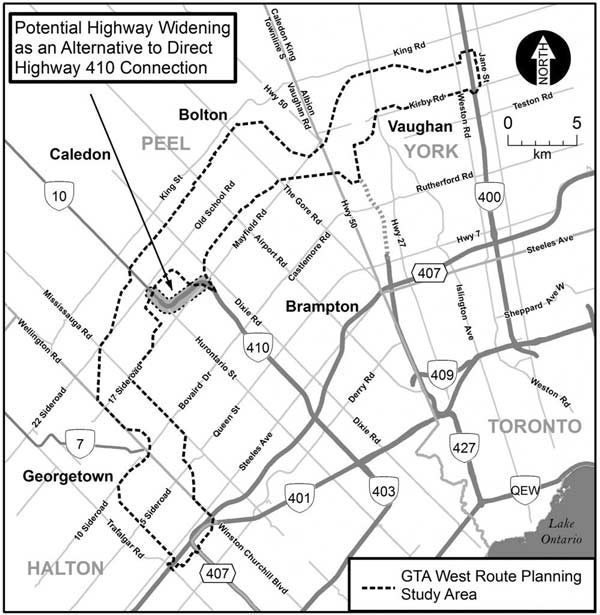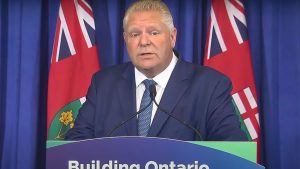A major 400-series highway project proposed for the northwest end of Greater Toronto Area (GTA) that was shelved four years ago by the previous Liberal government has been revived by the Progressive Conservatives (PCs).
The province is resuming work on an environmental assessment (EA) for the venture, known as the Greater Toronto Area West Highway Corridor, in an effort to improve the highway network and help reduce congestion and travel times for the trucking industry and commuters in Brampton and across the GTA. Information sessions are now being held to collect input on a preferred route.
The corridor for the thoroughfare is an orbital beltway that stretches roughly 60 kilometres from the Highway 401/407 interchange in Milton, Ont., through parts of Caledon and Brampton to Highway 400 and the Kirby Road area in Vaughan. It would run south of Georgetown and Bolton.
Bob Nichols, senior media liaison officer at the Ontario Ministry of Transportation, confirmed the EA will resume at the point it left off in 2015 and should be completed by the end of 2022. The project team is now working to update the evaluation of the shortlist of preferred routes for the thoroughfare.
“The Greater Golden Horseshoe (GGH) is an economic driver for the province and addressing transportation needs in the GGH is essential to the competitiveness of our economy,” he said. “The GTA West Transportation Corridor is vital transportation infrastructure that will help meet the projected growth in both population and employment identified in the growth plan for the Greater Golden Horseshoe.”
The EA will identify the official route, determine interchange locations and complete the preliminary design for the new corridor and four-to-six-lane highway.
The Liberals originally began an EA on the project in 2007, freezing property development for landowners and businesses in the corridor. The project team had identified a technically preferred route, but it was put on hold to explore other transportation and infrastructure options such as light rail.

The PCs maintain a new highway is needed because the population of the GGH is forecast to grow to 11.5 million people by 2031, resulting in approximately 1.5 million additional trips by cars and trucks per day. Without changes, by 2031 the average commute times are expected to increase by 27 minutes a day.
Bryan Hocking, chief operating officer of the Ontario Road Builders’ Association (ORBA), issued a statement on the EA.
“ORBA has long called for sustained transportation investment,” he said. “The cost of congestion to the provincial economy is estimated to be $6 billion in the GTHA (Greater Toronto Hamilton Area) alone and is projected to grow to $15 billion by 2031.
“Major projects like the GTA West Highway Corridor have the potential to create jobs, reduce congestion and enhance community connectivity,” he noted. “So, we’re certainly monitoring the progress of the study for the protection of Ontario’s environment and for sustainable economic growth.”
Jeff Yurek, who was then minister of transportation and is now minister of the environment, said in a statement that resuming the EA for the GTA West Corridor will ensure the province can build more transportation infrastructure in the future that meets the needs of people as the provincial economy grows.
“Our government will continue to invest and build new, efficient infrastructure to move people and goods faster,” he said.
There are concerns among environmentalists, however, that a new thoroughfare would set a dangerous precedent that would lead to paving through the Greenbelt to build more houses. Others, like Wellington-Halton Hills Progressive Conservative MPP Ted Arnott, are concerned about specifics of the route.
Arnott fought against the Liberal government’s preferred route, known as Alternative 4-3, and called for a suspension of the EA, as did Halton Hills council because it would basically cut the community in half and have a severe impact on the local environment, heritage, historical sites and good quality farmland.
Arnott recently wrote a letter to Transportation Minister Caroline Mulroney, reiterating his concerns about the route and expressed support for another route that is supported by Halton Hills council known as Alternative 4-2 which would essentially follow the path of a Halton-Peel Boundary Area Transportation Study corridor alignment and lead to widening of Highway 401 through Halton Region.
“We felt that widening of the 401 might be a more cost-effective option,” he said. “In fact, the Town of Halton Hills paid for an engineering study which drew that very conclusion. I certainly supported the Town of Halton Hills contention that Alternative 4-3 was not in the interests of the Town of Halton Hills.”
The Ministry of Transportation says a route will eventually be chosen based on feedback from the public, advisory groups and stakeholders.
Once EA approval is obtained, the project team will still have to survey the area, test soil conditions and develop the design details for the new highway, interchanges and bridges. No timeline has been set for construction to begin.










Recent Comments